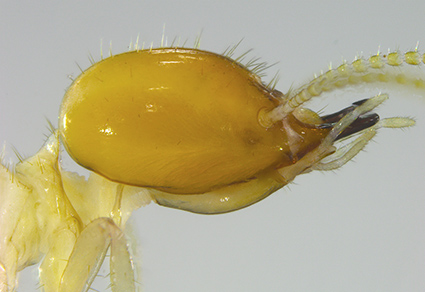Abstract
Amitermes californicus Banks, 1920 was described from southern California and southern Arizona but was later synonymized with A. wheeleri (Desneux, 1906) from Texas. Examination of material across the southwestern Nearctic and Mexico revealed that both are good species that are easily separated by the soldier mandibles. Amitermes floridensis Scheffrahn, 1989 is now a synonym of A. wheeleri. The establishment of A. wheeleri (=floridensis) in Florida is suggested to be the result of the ornamental palm trade from the southwestern United States. New collection records show that A. wheeleri has not been found in California.
References
Banks, N. & Snyder, T.E. (1920) A revision of the Nearctic termites, with notes on the biology and distribution of termites. United States National Museum Bulletin, 108, 1–85. https://doi.org/10.5479/si.03629236.108.i
Bomhard, M.L. (1950) Palm trees in the United States. No. 22. US Department of Agriculture, Forest Service, Washington, D.C., 26 pp.
Desneux, J. (1906) Variétés termitologiques. Annales de la Société Entomologique de Belgique, 49, 336–360.
Ettershank, G., Ettershank, J.A. & Whitford, W.G. (1980) Location of food sources by subterranean termites. Environmental Entomology, 9, 645–648. https://doi.org/10.1093/ee/9.5.645
Haverty, M.I. & Nutting, W.L. (1975) Density, dispersion, and composition of desert termite foraging populations and their relationship to superficial dead wood. Environmental Entomology, 4, 480–486. https://doi.org/10.1093/ee/4.3.480
Haverty, M.I., Nutting, W.L. & Lafage, J.P. (1976) A comparison of two techniques for determining abundance of subterranean termites in an Arizona desert grassland. Insectes Sociaux, 23, 175–178. https://doi.org/10.1007/BF02223850
Johnson, K.A. & Whitford, W.G. (1975) Foraging ecology and relative importance of subterranean termites in Chihuahuan Desert ecosystems. Environmental Entomology, 4, 66–70. https://doi.org/10.1093/ee/4.1.66
Krishna, K., Grimaldi, D.A., Krishna, V. & Engel, M.S. (2013) Treatise on the Isoptera of the world: Vol. 6. Termitidae. Bulletin of the American Museum of Natural History, 377, 1988–2432. https://doi.org/10.1206/377.6
Light, S.F. (1930a) The California species of the genus Amitermes Silvestri (Isoptera). University of California Publications in Entomology, 5, 173–214.
Light, S.F. (1930b) The Mexican species of Amitermes Silvestri (Isoptera). University of California Publications in Entomology, 5, 215–233.
Light, S.F. (1931) The termites of Nevada. Pan-Pacific Entomologist, 8, 5–9.
Light, S.F. (1932) Contribution toward a revision of the American species of Amitermes Silvestri. University of California Publications in Entomology, 5, 355–414.
Light, S.F. (1934) The desert termites of the genus Amitermes. In: Kofoid, C.A. (Ed.) Termites and Termite Control. 2nd Edition. University of California Press, Berkeley, California, pp. 199–205.
Nickle, D.A. & Collins, M.S. (1988) The termite fauna (Isoptera) in the vicinity of Chamela, State of Jalisco, Mexico. Folia Entomológica Mexicana, 77, 85–122.
Noirot, C. (2001) The gut of termites (Isoptera). Comparative anatomy, systematics, phylogeny. II. Higher termites (Termitidae). Annales de la Société Entomologique de France, 37, 431–471.
Nutting, W.L. (1990) Insecta: Isoptera. In: Dindal, D.L (Ed.), Soil Biology Guide. John Wiley & Sons, New York, New York, pp. 997–1032.
Scheffrahn, R.H. (2019) University of Florida Termite Collection (UFTC). Available from: https://www.termitediversity.org/ (accessed 30 September 2021)
Scheffrahn, R.H., Gaston, L.K., Sims, J.J. & Rust, M.K. (1983) Identification of the defensive secretion from soldiers of the North American termite, Amitermes wheeleri (Desneux) (Isoptera: Termitidae). Journal of Chemical Ecology, 9, 1293–1305. https://doi.org/10.1007/BF00994798
Scheffrahn, R.H., Gaston, L.K., Nutting, W.L. & Rust, M.K. (1986a) Chemical heterogeneity of soldier defensive secretions in the desert subterranean termite, Amitermes wheeleri. Biochemical Systematics and Ecology, 14, 661–664. https://doi.org/10.1016/0305-1978(86)90049-9
Scheffrahn, R.H., Sims, J.J., Lee, R K. & Rust, M.K. (1986b) Helminthogermacrene, a major component in the defensive secretion of the Nearctic termite, Amitermes wheeleri. Journal of Natural Products, 49, 699–701. https://doi.org/10.1021/np50046a028
Scheffrahn, R.H., Su, N.-Y. & Mangold, J.R. (1989) Amitermes floridensis, a new species and first record of a higher termite in the eastern United States (Isoptera: Termitidae: Termitinae). Florida Entomologist, 72, 618–625. https://doi.org/10.2307/3495036
Scheffrahn, R.H. & Su, N.-Y. (1994) Keys to soldier and winged adult termites (Isoptera) of Florida. Florida Entomologist, 77, 460-474. https://doi.org/10.2307/3495700
Taylor, H.S., MacKay, W.P., Herrick, J.E., Guerrero, R.A. & Whitford, W.G. (1998) Comparison of field methods to detect termite activity in the Northern Chihuahuan Desert (Isoptera). Sociobiology, 32, 1–16.
Weesner, F.M. (1965) Termites of the United States: a handbook. National Pest Control Association, Elizabeth, New Jersey, 70 pp.
Whitford, W.G. (1999) Activity of subterranean termites in arid southeastern New Mexico (lsoptera). Sociobiology, 34, 493–504.


